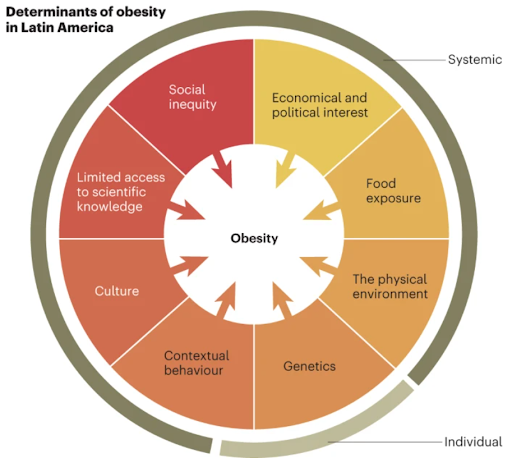A recent study has reviewed the main determinants of obesity and discussed how they impact obesity rates in Latin America. The review identifies eight determinants of obesity; physical environment, food exposure, economic and political interest, social inequality, limited access to scientific knowledge, culture, contextual behaviour and genetics. The authors analyse these determinants in the context of Latin America to provide evidence and guidance for public policy and strategy aimed at understanding and slowing the growth rate of obesity.

Summary
A recent study has reviewed the main determinants of obesity, a global public health problem connected to comorbidities and premature death. Obesity, a disease of excess body fat, creates substantial financial costs to society through associated health damages to individuals with the disease. Obesity elevates rates of type 2 diabetes mellitus, hypertension, polycystic ovary syndrome, depression, certain types of cancer and many other diseases. The authors cite estimations of increased prevalence of obesity worldwide regardless of age group, but especially among young people. The authors note differing rates of obesity in high- and low- or middle- income countries with recent trends indicating steep rises in obesity among adolescents in low-income countries.
The authors have observed this recent trend cannot be explained by genetic factors and individual choices;; rather, systemic determinants (rooted in where a person lives and the resources available to them) elucidate the driving forces of this trend. The authors focus specifically on how these determinants impact obesity rates in Latin America as a case study of a low- or middle income region. They investigate Mexico, Brazil, Columbia, Argentina and Chile and find that overall, young boys, women and underprivileged individuals are generally at a higher risk of developing obesity in Latin America. They observe regional and class differences in obesity rates in each country and emphasise the importance of contextual interventions to address these differences.
The authors argue against claims that place the burden of obesity on individuals' choices and genetics rather than systemic factors such as access to scientific knowledge and social inequalities. A visual representation of these determinants of obesity can be seen in Figure 1.

Figure 1: Eight determinants of obesity in Latin America
The physical environment of Latin America has undergone significant changes due to rapid industrialization, urbanisation and agricultural practice changes which have all contributed to pollution, water and food contamination and deforestation. The authors review links between these environmental changes and health.
They find a major determinant of obesity to be the rapid dietary transition in recent decades associated with increased consumption of poor nutritional quality, calorie-dense and ultra-processed foods (UPFs). UPFs are often considered drivers of weight gain but others disagree with the use of the classification system (see our Letterbox series).
The authors reviewed economic and political interests as drivers of obesity. They find large food manufacturers have gained significant lobbying power which can interfere with policy efforts to curtail rising obesity rates. They also find social inequalities, such as economic, education and barriers to healthcare directly impact people’s ability to access appropriate nutrition. They find an association between education levels and obesity but note contextual differences in these trends. When education level is considered as a single determinant, there is no clear association with obesity rates.. When combined with other determinants, education level can serve as a protective factor, with higher levels of education generally associated with lower rates of obesity.
The authors also find that limited access to scientific knowledge (meaning data related to obesity), especially research related to populations in low-income regions, appears to have some links to rates of obesity but note less evidence found in the review to support this link.
They additionally considered the role of culture (defined as the traditional behaviour, values, beliefs and lifeway of a society) in driving rates of obesity. They found that significant disruption in cultural eating habits has occurred in the regions of study. Debates around the classification of obesity as a real ‘disease’ have also contributed to confusion encouraged by the UPF industry. Finally, the historical background, socioeconomic circumstances and technological advances an individual has access to can change decision making processes and actions which ultimately impact behaviour. In other words, a person's behaviour, such as physical activity, eating habits and sleeping patterns are contextual.
These determinants are then used to speculate on the possible explanations for surging rates of obesity in Latin America and to provide intervention priorities in efforts to combat the issue. The authors propose the use of their determinants framework as an aid in developing public policy and strategies in Latin American Countries. They call for multidisciplinary, global approaches to understand and prevent obesity growth should consider individual and systemic levels of disease complexity and regional differences.
Abstract
Obesity rates are increasing almost everywhere in the world, although the pace and timing for this increase differ when populations from developed and developing countries are compared. The sharp and more recent increase in obesity rates in many Latin American countries is an example of that and results from regional characteristics that emerge from interactions between multiple factors. Aware of the complexity of enumerating these factors, we highlight eight main determinants (the physical environment, food exposure, economic and political interest, social inequity, limited access to scientific knowledge, culture, contextual behaviour and genetics) and discuss how they impact obesity rates in Latin American countries. We propose that initiatives aimed at understanding obesity and hampering obesity growth in Latin America should involve multidisciplinary, global approaches that consider these determinants to build more effective public policy and strategies, accounting for regional differences and disease complexity at the individual and systemic levels.
Reference
Ferreira, S.R.G., Macotela, Y., Velloso, L.A., Mori, M.A., 2024. Determinants of obesity in Latin America. Nature Metabolism 1–24.
Read more here and see our discussion paper What is a sustainable healthy diet? and our letterbox series Is the Ultra-processed Food (UPF) concept useful, and for what goals?




Comments (0)